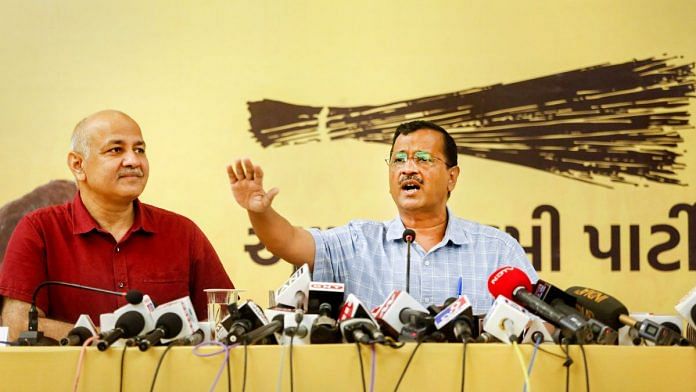
Thank you dear subscribers, we are overwhelmed with your response.
Your Turn is a unique section from ThePrint featuring points of view from its subscribers. If you are a subscriber, have a point of view, please send it to us. If not, do subscribe here: https://theprint.in/
The election campaign is on steroids and the political gladiators have entered the political amphitheatres, since the ruling BJP is facing anti-incumbency on many fronts after a reign of 25 years, which was also electorally visible in the 2017 Assembly election primarily in the rural Gujarat. Five years ago, assembly elections were held in Gujarat in the shadow of massive protests by the Patel community to demand reservations in government jobs. The beneficiary of the rural distress, agrarian crisis and the Patidar agitation was solely the Congress party.
In the 2017 polls, the rural areas mostly dominated by Saurashtra and Kutch region, collectively had 54 seats out of which Congress won 30 seats in an unprecedented show of strength. In 2012, the BJP had won 31 seats in the Saurashtra region (total 48 seats), but its tally dropped to 19 in 2017. Also, in 2017 Congress MP Rahul Gandhi spent 45 days in Gujarat on a trot which somehow spirited the party workers. But the Congress doesn’t seem to be the favoured choice of disgruntled farmers. Instead, in the areas across south Saurashtra districts of Rajkot, Amreli and Junagadh, many are cautiously eyeing a relatively new entrant to Gujarat’s electoral fray: the Aam Aadmi Party.
One political party has cleared the pitch in what has been a political contest between the BJP and Congress. The AAP is challenging the BJP and is hungry to occupy the political space, ceded by the Congress. Is there a political buzz with AAP entering the political frame in Gujarat? Yes; Will AAP eat into vote share of Congress and can AAP make real political impact that is tangible and translated into seats? Time will entail. And since time is of essence, on ground Congress seems to be running out of it. AAP national convener Arvind Kejriwal is visible more in Gujarat than in Delhi, as he is campaigning every three days in the western state. Even BJP’s top guns are booming with party president JP Nadda announcing “Namo Kisan Panchayat” on September 17 (PM Narendra Modi’s birthday) to connect with the farmers and advertise and spread awareness regarding the centre and state government policies benefiting the farmers. But is AAP’s rise in Gujarat a threat for the BJP or is it sheer bluster and theatrics? AAP received 24,918 votes or 0.1% vote share in 2017 polls, to which any political pundit would say that the party is creating castles in air and only has gas filled in it. But the outcome of the 2021 Surat Municipal Corporation polls was startling. Out of 120 wards, BJP won 93 and Congress 0 but AAP won 27 wards and announced its arrival. If we perceive the upcoming polls from the 2017 prism, then it would be a biased approach.
In the last five years, 22 MLAs who won on a Congress ticket – seven of them from Saurashtra alone – have switched to the ruling BJP so far; alongside the face of Patidar agitation Hardik Patel. To add on, the weak point in BJP’s juggernaut i.e Saurashtra, has been no better. The 2016 Rajkot Municipal elections was a close affair when the Congress won 34 seats and BJP settled with 38 out of total 72 seats. But in 2021, the BJP won a landslide victory, winning 68 of the 72 seats. The BJP’s stronghold, i.e the urban areas has historically voted only for the saffron party in the last 25 years. In 2017, out of 39 heavily urbanised seats, BJP won 35 of them. But their woes remained in the rural dominated region which comprised 143 seats, and BJP won merely 64 of them. In order to correct its image and position in these areas, the BJP-led union government announced 10% reservation for the economic weaker section (EWS) among general category such as Patels and the Gujarat government was the first in the country to implement it, post centre’s notification.
AAP would require a huge swing to convert the narrative and momentum it is building into actual seats in Gujarat, since it is a much larger and more complex state than Delhi or Punjab. Although disproportionate importance is being given to Arvind Kejriwal, he is making the Gujarat election look like AAP vs BJP, the same model he applied in Delhi and Punjab polls respectively. There is certainly a space and vacuum being created in a large anti-BJP space that exists in Gujarat. During the 1970’s, when Congress was a dominant party, a large section of anti-Congress space existed and the likes of Babubhai Patel became Chief Minister of Gujarat while being a part of the then Janata Party.
Also read: SubscriberWrites: ‘Democracy 2.0’ — A new definition of democracy is needed in changing times
These pieces are being published as they have been received – they have not been edited/fact-checked by ThePrint.

COMMENTS